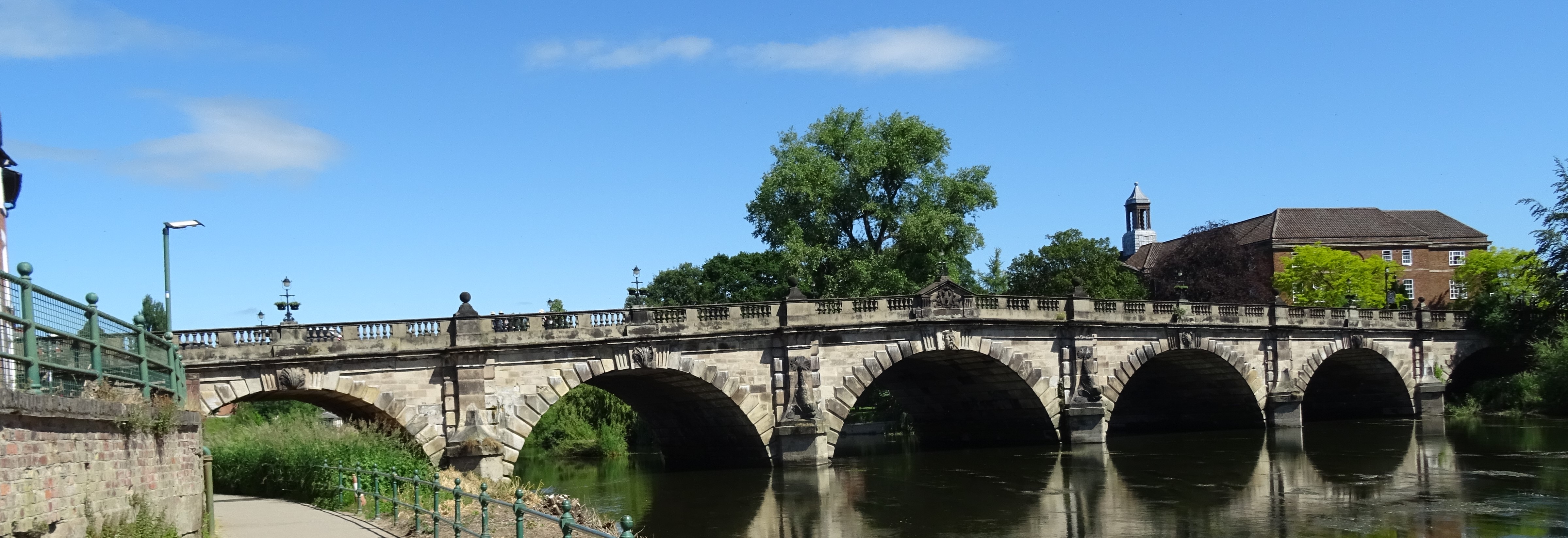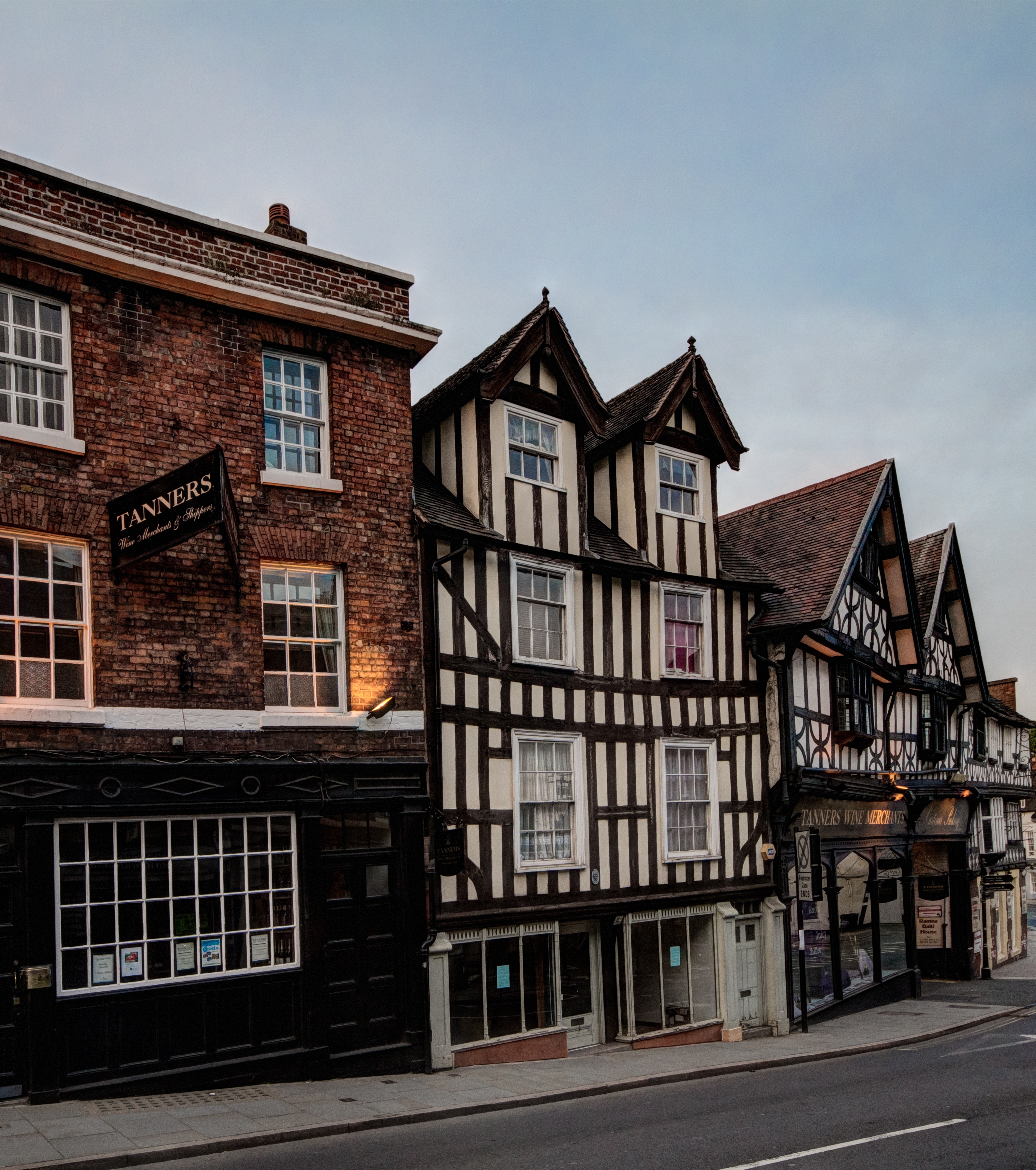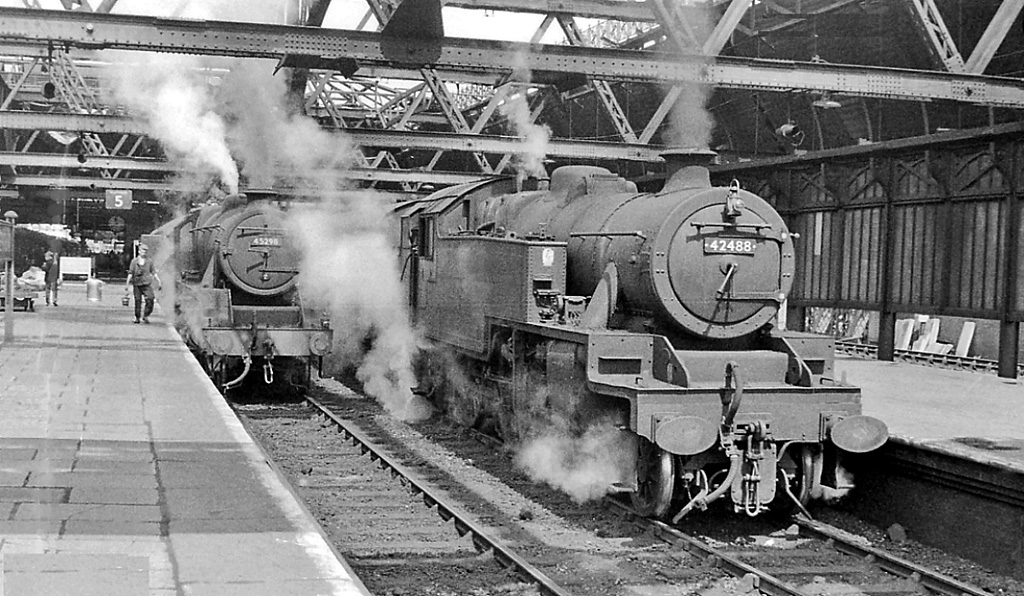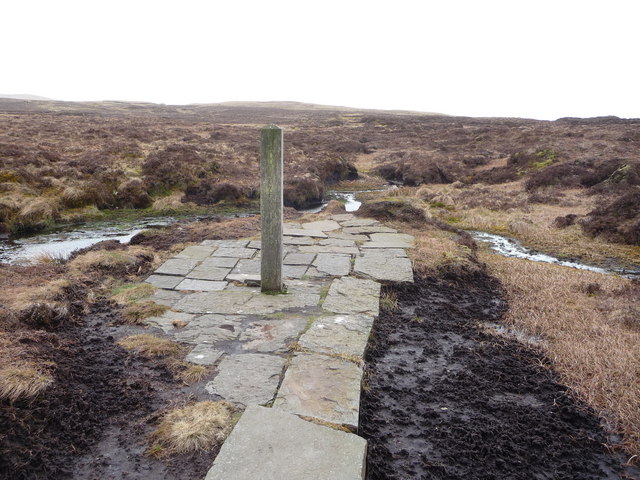|
English Bridge
The English Bridge is a masonry arch viaduct, crossing the River Severn in Shrewsbury, Shropshire. The present bridge is a 1926 rebuilding and widening (re-using the original masonry) of John Gwynn's design, completed in 1774. A bridge is known to have stood at this spot since at least Norman times. Historically, it was known as the "Stone Bridge". It is a Grade II* listed building. The original Norman bridge consisted of five arches and a timber causeway. A large tower stood on the East bank, housing a gate and a drawbridge. The bridge also supported several shops and houses. Building work on Gwynn's replacement bridge started on 29 June 1769, and comprised seven semicircular arches, long. This bridge cost £16,000. The span central arch was built high, to provide headroom to watercraft, but this resulted in steep approaches. As a result, a new design was put forward in 1921 by Arthur W. Ward, the Borough Surveyor. This lowered all the arches, converting the central ... [...More Info...] [...Related Items...] OR: [Wikipedia] [Google] [Baidu] |
Shrewsbury
Shrewsbury ( , also ) is a market town, civil parish, and the county town of Shropshire, England, on the River Severn, north-west of London; at the 2021 census, it had a population of 76,782. The town's name can be pronounced as either 'Shrowsbury' or 'Shroosbury', the correct pronunciation being a matter of longstanding debate. The town centre has a largely unspoilt medieval street plan and over 660 listed buildings, including several examples of timber framing from the 15th and 16th centuries. Shrewsbury Castle, a red sandstone fortification, and Shrewsbury Abbey, a former Benedictine monastery, were founded in 1074 and 1083 respectively by the Norman Earl of Shrewsbury, Roger de Montgomery. The town is the birthplace of Charles Darwin and is where he spent 27 years of his life. east of the Welsh border, Shrewsbury serves as the commercial centre for Shropshire and mid-Wales, with a retail output of over £299 million per year and light industry and distributi ... [...More Info...] [...Related Items...] OR: [Wikipedia] [Google] [Baidu] |
Thomas Telford
Thomas Telford FRS, FRSE, (9 August 1757 – 2 September 1834) was a Scottish civil engineer. After establishing himself as an engineer of road and canal projects in Shropshire, he designed numerous infrastructure projects in his native Scotland, as well as harbours and tunnels. Such was his reputation as a prolific designer of highways and related bridges, he was dubbed ''The Colossus of Roads'' (a pun on the Colossus of Rhodes), and, reflecting his command of all types of civil engineering in the early 19th century, he was elected as the first President of the Institution of Civil Engineers, a post he held for 14 years until his death. The town of Telford in Shropshire was named after him. Early career Telford was born on 9 August 1757, at Glendinning, a hill farm east of Eskdalemuir Kirk, in the rural parish of Westerkirk, in Eskdale, Dumfriesshire. His father John Telford, a shepherd, died soon after Thomas was born. Thomas was raised in poverty by his mother Janet Jac ... [...More Info...] [...Related Items...] OR: [Wikipedia] [Google] [Baidu] |
Bridges Completed In 1774
A bridge is a structure built to span a physical obstacle (such as a body of water, valley, road, or rail) without blocking the way underneath. It is constructed for the purpose of providing passage over the obstacle, which is usually something that is otherwise difficult or impossible to cross. There are many different designs of bridges, each serving a particular purpose and applicable to different situations. Designs of bridges vary depending on factors such as the function of the bridge, the nature of the terrain where the bridge is constructed and anchored, and the material used to make it, and the funds available to build it. The earliest bridges were likely made with fallen trees and stepping stones. The Neolithic people built boardwalk bridges across marshland. The Arkadiko Bridge (dating from the 13th century BC, in the Peloponnese) is one of the oldest arch bridges still in existence and use. Etymology The ''Oxford English Dictionary'' traces the origin of the wo ... [...More Info...] [...Related Items...] OR: [Wikipedia] [Google] [Baidu] |
Grade II* Listed Buildings In Shropshire
The county of Shropshire in England is divided into two unitary authorities: Telford and Wrekin and Shropshire Council. As there are 361 Grade II* listed buildings in the county they have been split into separate lists for unitary authority. *Grade II* listed buildings in Shropshire Council (A–G) * Grade II* listed buildings in Shropshire Council (H–Z) * Grade II* listed buildings in Telford and Wrekin See also *Grade I listed buildings in Shropshire Grade most commonly refers to: * Grade (education), a measurement of a student's performance * Grade, the number of the year a student has reached in a given educational stage * Grade (slope), the steepness of a slope Grade or grading may also r ... ReferencesNational Heritage List for England {{DEFAULTSORT:Grade II listed buildings in Shropshire [...More Info...] [...Related Items...] OR: [Wikipedia] [Google] [Baidu] |
Bridges Across The River Severn
A bridge is a structure built to span a physical obstacle (such as a body of water, valley, road, or rail) without blocking the way underneath. It is constructed for the purpose of providing passage over the obstacle, which is usually something that is otherwise difficult or impossible to cross. There are many different designs of bridges, each serving a particular purpose and applicable to different situations. Designs of bridges vary depending on factors such as the function of the bridge, the nature of the terrain where the bridge is constructed and anchored, and the material used to make it, and the funds available to build it. The earliest bridges were likely made with fallen trees and stepping stones. The Neolithic people built boardwalk bridges across marshland. The Arkadiko Bridge (dating from the 13th century BC, in the Peloponnese) is one of the oldest arch bridges still in existence and use. Etymology The ''Oxford English Dictionary'' traces the origin of the wo ... [...More Info...] [...Related Items...] OR: [Wikipedia] [Google] [Baidu] |
Shrewsbury Railway Station
Shrewsbury railway station is in Shrewsbury, Shropshire, England. Built in 1848, it was designated a grade II listed building in 1969. The station is north west of Birmingham New Street. Many services starting at or passing through the station are bound for Wales; it is operated by Transport for Wales, although the station is also served by Avanti West Coast and West Midlands Railway services, and is one of the key network hubs of Transport for Wales. History The station was formerly known as Shrewsbury General and is the only remaining railway station in the town; Shrewsbury Abbey, as well as other small stations around the town, having long closed. Shrewsbury railway station was originally built in October 1848 for the county's first railway — the Shrewsbury to Chester Line. The architect was Thomas Mainwaring Penson of Oswestry. The building is unusual, in that the station was extended between 1899 and 1903 by the construction of a new floor underneath the original ... [...More Info...] [...Related Items...] OR: [Wikipedia] [Google] [Baidu] |
Coleham
Coleham is a district of the town of Shrewsbury in Shropshire, England. It is located just south, over the River Severn, from Shrewsbury town centre. History Coleham grew up as a village outside medieval Shrewsbury, with the nearest crossing over the Severn to the town being the Stone Bridge (now the English Bridge). Shrewsbury Abbey and its associated lands and buildings were nearby. The Rea Brook separates Coleham from the other old suburb on this end of town – Abbey Foregate. Coleham is centered on the Shrewsbury to Longden road, which as it passes through Coleham itself is called "Longden Coleham". The Victorian suburb of Belle Vue grew up south of Coleham and the wealthy suburb of Kingsland (which centres on Shrewsbury School) grew up west of Coleham. The first large scale industrial building in Shrewsbury arose in Coleham when in 1790 the firm of Powis & Hodge built three factory buildings on land bought from John Carline at the junction of Longden Coleham and Coleh ... [...More Info...] [...Related Items...] OR: [Wikipedia] [Google] [Baidu] |
List Of Crossings Of The River Severn
This is a list of crossings of the River Severn in Great Britain (including bridges, tunnels, ferries and fords), in order from source to mouth. The Severn has historically been a very important and busy river, and has been bridged throughout history. The bridges that stand today are often of great historical and/or engineering interest. For example, the world's first iron bridge, The Iron Bridge, built from cast iron, crosses the River Severn at Ironbridge Gorge. The Iron Bridge is one of three bridges on the River Severn that are listed as grade I structures, including Bewdley Bridge and the Severn Bridge, which was opened in 1966. In total, 31 bridges that cross the River Severn are listed, either grade I, II* or II. Four bridges are scheduled monuments, including The Iron Bridge, which are nationally important archaeological bridges. Many reaches of the Severn are prone to severe flooding, prompting the design of some unique bridges to cope with this. There were histor ... [...More Info...] [...Related Items...] OR: [Wikipedia] [Google] [Baidu] |
Shrewsbury Abbey
The Abbey Church of Saint Peter and Saint Paul, Shrewsbury (commonly known as Shrewsbury Abbey) is an ancient foundation in Shrewsbury, the county town of Shropshire, England. The Abbey was founded in 1083 as a Benedictine monastery by the Norman Earl of Shrewsbury, Roger de Montgomery. It grew to be one of the most important and influential abbeys in England, and an important centre of pilgrimage. Although much of the Abbey was destroyed in the 16th century, the nave survived as a parish church, and today serves as the mother church for the Parish of Holy Cross. The Abbey is a Grade I listed building and is a member of the Greater Churches Group. It is located to the east of Shrewsbury town centre, near the English Bridge, and is surrounded by a triangular area which is today referred to as Abbey Foregate. History Foundation Before the Norman conquest a small Saxon chapel dedicated to St Peter stood outside the east gate of Shrewsbury; it had been built by Siward, son o ... [...More Info...] [...Related Items...] OR: [Wikipedia] [Google] [Baidu] |
Belle Vue, Shrewsbury
Belle Vue is a suburb of the town of Shrewsbury, Shropshire. It is located about a mile south of the town centre. The population of the ward at the 2011 census was 4,550. History and development Built up during the 19th and early 20th Centuries, it is now mainly residential. "Belle Vue Road" (the A5191, formerly the A49) runs through the middle of the area, which has many public houses such as The Grove, the Belle Vue Tavern, the Masonic Arms and the Boar's Head. It also has a selection of small shops, though many have become houses in recent decades. Also in the suburb, off the Belle Vue Road, is the Prince of Wales public house, which has its own bowling green. Streets branching off the Belle Vue Road include Greyfriars Road, Trinity Street, Havelock Road, South Hermitage and Belle Vue Gardens. Oakley Manor, now private housing, was one of the locations of Shrewsbury and Atcham Borough Council from the 1970s to the early 2000s, before the council moved to a purpose-built Gu ... [...More Info...] [...Related Items...] OR: [Wikipedia] [Google] [Baidu] |


.jpg)



